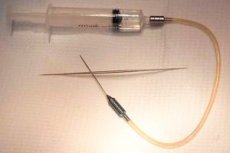Medical expert of the article
New publications
Probing the lacrimal duct in newborns
Last reviewed: 06.07.2025

All iLive content is medically reviewed or fact checked to ensure as much factual accuracy as possible.
We have strict sourcing guidelines and only link to reputable media sites, academic research institutions and, whenever possible, medically peer reviewed studies. Note that the numbers in parentheses ([1], [2], etc.) are clickable links to these studies.
If you feel that any of our content is inaccurate, out-of-date, or otherwise questionable, please select it and press Ctrl + Enter.

Probing the tear duct in newborns is a procedure for cleaning the eye from secretions that cannot be evacuated on their own. This procedure is considered an operative manipulation that is carried out when other methods are ineffective. The procedure is not as complicated as it is frightening for parents, which is absolutely unjustified.
 [ 1 ]
[ 1 ]
Indications for the procedure
When a child is in the womb, its eyes are closed most of the time. The structure of the eye is such that the lacrimal canals and lacrimal sac are located at the inner corner, where tears and any secretions are collected. This sac opens into the nasal cavity, where excess tears or fluid flows. In a child, when it is in the mother's tummy, this channel can be closed by a mucous plug, which should come off after birth. But it happens that it does not come off completely or remains in the same place. This leads to the fact that tears cannot flow freely from the mucous sac and stagnate there, which causes inflammation. This process is called dacryocystitis.
The mother can see the symptoms of dacryocystitis immediately when the child starts crying. This is usually a one-sided process, so the changes occur in one eye. In this case, the inner eyelid swells and constantly waters. After sleep, a plug can form there, which even makes it difficult to open the eye normally. If the process is long-term, the discharge from the eye can be purulent and green. The body temperature can rise as a reaction to such local inflammation.
In any case, a consultation with an ophthalmologist is required to confirm the diagnosis.
Treatment is initially carried out using conservative methods. Initial therapy is eyelid massage, which improves the outflow of secretion and can break through the plug. If the process is purulent, then massage is not indicated, since the infection will spread. In this case, treatment can begin with antibiotics and invasive interventions.
Massage for dacryocystitis is done by the mother according to the doctor's instructions. This treatment can be used from two to four weeks. As a rule, it is very effective and enough for everything to pass. But if such treatment is ineffective, then probing of the lacrimal canal is carried out, thus breaking through this mucous plug.
Indications for such a procedure are dacryocystitis, which is not treated by massage. If the case is neglected, then sometimes probing is performed immediately after the diagnosis is established.
 [ 2 ]
[ 2 ]
Preparation
Before the procedure, parents often ask whether probing the tear duct in newborns is dangerous. In fact, it is not dangerous at all, because the procedure is performed only by an experienced doctor and does not pose a threat to life. The danger is always exaggerated due to the fact that the manipulation is performed on the eye, so it can be scary for parents.
Preparation for the procedure does not require any special actions, the only condition is that the child must be completely healthy at this time. After all, if there is a runny nose or any other disease, it will complicate the healing.
 [ 3 ]
[ 3 ]
Technique of lacrimal duct probing in newborns.
The technique is very simple and the procedure itself takes a few minutes. It is carried out under local anesthesia after instilling an antiseptic into the eye. A special probe is inserted into the inner part of the eyelid and moved in the direction of the lacrimal sac. After several movements, the mucous plug is pushed out through the nose and all the mucus and tears flow out through this channel. Then, an antiseptic is instilled into the eye and it is washed again. That's the whole procedure.
Feedback on the procedure
Reviews from mothers whose children have undergone such a procedure are only positive. Mothers say that thanks to this, the child has only just begun to "live" normally and there are no problems with constant soreness of the eye and tearing.
Probing the tear duct in newborns is not such a scary and dangerous procedure, as it is necessary for dacryocystitis. The technique is simple and complications are very rare. The main thing in treatment is proper care after the procedure, and then the child will always "cry without pain."

